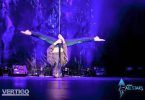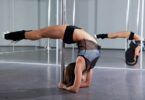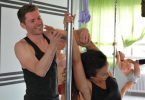Feeling the burn after a killer pole dancing session? Don’t let soreness slow you down! We’ll unveil the most common pole dance recovery mistakes and show you how to dodge them like a pro, so you can keep slaying those routines.
Let’s face it, pole dancing is an incredible workout. It’s empowering, it’s challenging, and it leaves you feeling like a total badass. But let’s be honest, those gravity-defying moves can leave you feeling a little worse for wear the next day. Don’t worry, you’re not alone! Even the most seasoned pole dancers can fall victim to common recovery mistakes. But fear not, fellow pole enthusiasts! This guide will unveil those sneaky pitfalls and show you exactly how to avoid them like a pro.

Common Pole Dance Recovery Mistakes (and How to Slay Them!)
- Recovery Pole Essentials: Why You Shouldn’t Skip the Cool-Down: Just like you wouldn’t slam on the brakes after speeding down the highway, your body needs a gentle transition after an intense pole session. A cool-down with light stretches helps your body flush out toxins, prevent muscle soreness, and improve flexibility. Think of it as giving your muscles a high five for all their hard work!
How to Slay It: Dedicate 5-10 minutes after your workout to gentle stretches that target the major muscle groups you used. Focus on your shoulders, back, core, legs, and wrists.
- Recovery Pole Tip: Stay Hydrated for Faster Recovery: Water is your BFF, especially after a sweaty pole session. Dehydration can lead to muscle cramps, fatigue, and even hinder your recovery. Aim to sip on water throughout your workout and continue to do so afterwards.
How to Slay It: Keep a reusable water bottle handy during your practice and take frequent sips. You can also track your water intake using a handy app to make sure you’re staying properly hydrated.
- Neglecting Fuel: Just like a car needs gas to run, your body needs fuel to recover. Don’t skip that post-workout meal! Aim for a balanced combination of protein and carbohydrates to help rebuild muscle tissue and replenish your energy stores.
How to Slay It: Pack a healthy snack like a protein bar with some fruit or a smoothie made with Greek yogurt and berries to refuel after your workout.
- Pushing Through Pain: Listen to your body, friend! There’s a difference between pushing yourself to achieve a new move and pushing through pain. Pain is your body’s way of saying “Whoa there, slow down!” Ignoring it can lead to injuries that will sideline you for much longer than a little soreness. Train hard, recover smart! When you’re reaching for those new heights on the pole, a reliable crash mat can make all the difference. Designed for ultimate support and impact absorption, crash mats offer you a safety net during tricky moves and help prevent unnecessary injuries. Whether you’re a beginner or an advanced dancer, a high-quality crash mat is essential for safe, effective practice and can ease your recovery journey. Explore our range of durable crash mats and bring safety and confidence to every session!
How to Slay It: If you experience sharp pain, stop the move immediately. It’s okay to take a break, modify the move, or ask your instructor for guidance. Remember, progress over perfection!
- Sleeping on Subpar Sleep: Sleep is crucial for recovery, period. When you sleep, your body repairs itself and rebuilds muscle tissue. Aim for 7-8 hours of quality sleep each night to optimize your recovery and keep your energy levels soaring.
How to Slay It: Establish a relaxing bedtime routine to wind down before sleep. Avoid screens for at least an hour before bed, and create a sleep-conducive environment that’s cool, dark, and quiet.

Frequently Asked Questions (FAQs) About Pole Dance Recovery
Q: How long should I rest after a pole dancing session?
A: The amount of rest you need depends on the intensity of your workout and your individual needs. Generally, beginners may need a full day of rest between sessions, while more experienced dancers can practice more frequently (with proper recovery practices in place).
Q: Are there any supplements that can help with pole dance recovery?
A: Always consult with your doctor before taking any supplements. Some people find that protein powder, magnesium, and fish oil can be beneficial for recovery, but it’s important to get professional advice before adding anything to your routine.
Q: What should I do if I’m experiencing severe muscle soreness?
A: If you’re experiencing muscle soreness that is severe or doesn’t improve within a few days, it’s best to consult with a healthcare professional. They can rule out any underlying injuries and recommend the best course of treatment.
Bonus Tips for Stellar Pole Dance Recovery
- Self-Massage is Your Secret Weapon: Give your muscles some TLC with a foam roller or massage ball. Focus on rolling out tight areas like your glutes, quads, and shoulders. This can help improve circulation, reduce soreness, and promote faster recovery source: American Council on Exercise: [invalid URL removed].
- Stretch It Out, Even on Rest Days: Don’t relegate stretching to just after workouts! Dedicate 10-15 minutes on your rest days to some static stretches. This will help maintain your flexibility and prevent injuries in the long run.
- Ice It, Baby: If you’re dealing with localized soreness or a minor injury, applying ice for 15-20 minutes at a time (with a towel between your skin and the ice pack) can help reduce inflammation and pain.
- Listen to Your Body & Embrace Active Recovery: Some days, your body might just crave a chill session. Don’t force yourself into a high-intensity workout. Opt for a gentle yoga flow, a relaxing swim, or a walk in nature. Active recovery helps your body stay loose and promotes overall well-being.
- Fuel Your Body, Right: Diet plays a massive role in recovery. Make sure you’re eating a balanced diet rich in fruits, vegetables, whole grains, and lean protein. These foods provide your body with the essential nutrients it needs to repair and rebuild muscle tissue.
Remember, You Are What You Recover From!
By prioritizing proper recovery, you’ll not only prevent injuries and soreness, but you’ll also see faster progress in your pole dancing journey. You’ll be able to train harder, learn new tricks with more ease, and feel incredible throughout your entire pole dancing experience. So, fuel your body right, listen to its signals, and embrace recovery as an essential part of your pole dancing practice. Now go forth and conquer that pole like the badass you are!
Want to connect with other pole dancers and share your recovery tips? Join our Facebook group, ‘Pole & Aerial Events: Sharing Experiences!







